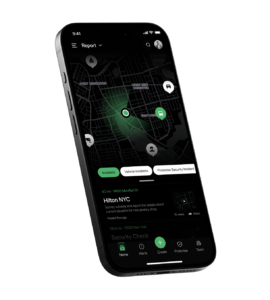From the outside, a successful executive protection operation might appear seamless—even uneventful. But beneath the surface lies a highly choreographed routine powered by vigilance, precision, and planning. Every day, an executive protection detail (EPD) operates in the background, ensuring their principal’s safety without disrupting their lifestyle or schedule.
This article gives you a behind-the-scenes look at what a typical day is like for a professional executive protection detail. We’ll explore the structure, roles, timelines, responsibilities, and the disciplined rhythm that keeps the wheels turning—often without the principal ever noticing.

What Is an Executive Protection Detail?
An executive protection detail is a coordinated team of professionals tasked with safeguarding a principal—typically a CEO, government official, celebrity, or ultra-high-net-worth individual (UHNWI). A full detail may include:
- Close Protection Agents
- Advance Agents
- Tactical Drivers
- Medical personnel
- Team Leader or Detail Leader (AIC – Agent in Charge)
- Logistics and communications support
The size and composition of an EPD varies depending on threat level, itinerary, geography, and client lifestyle. What doesn’t vary is the goal: to prevent risk, mitigate exposure, and enable the principal to operate freely and safely.
Core Functions of an Executive Protection Detail
While daily tasks shift based on the mission, the core responsibilities of an executive protection detail include:
- Conducting advance work and site surveys
- Escorting and physically protecting the principal
- Planning and securing travel routes
- Performing surveillance detection and situational scanning
- Liaising with venues, law enforcement, and private security
- Responding to emergencies (medical, tactical, or logistical)
- Maintaining operational communication and reporting
- Managing the principal’s exposure across digital and physical environments
A Typical Day for an Executive Protection Detail
Let’s walk through a sample 16-hour mission day for a corporate executive protection detail on assignment in a major city.
🕓 0400 – Pre-Shift Briefing & Morning Prep
- Team meets at secure operations base or designated rally point
- Threat intelligence updates are reviewed (overnight media, social feeds, alerts)
- Weather, traffic, protest activity, and local incidents are discussed
- Detail Leader confirms team roles, route plan, timing, and contingencies
- Comms gear, radios, panic buttons, and GPS devices are tested
- Team conducts vehicle inspections (fluids, tires, cameras, emergency kits)
- First vehicle advance moves out for early site checks
🕕 0600 – Advance Work & Site Verification
- Advance Agent conducts walkthroughs of all venues on the day’s itinerary
- Security staff are briefed, floor plans are confirmed
- Choke points, entrances, exits, and safe rooms are rechecked
- Local liaison (e.g., hotel or event manager) confirms operational cooperation
- Emergency medical contacts and nearest trauma centers reconfirmed
- Digital updates logged in mission software (e.g., AdvanceWork)
🕣 0830 – Principal Movement Begins
- Residential perimeter secured; vehicle positioned for low-profile pickup
- Driver confirms vehicle route status; alternate routes remain active
- Principal escorted to vehicle by primary executive protection agent
- Detail rolls out, maintaining secure convoy spacing and constant comms
🕘 0900 – Office or Venue Arrival
- Arrival team secures drop point minutes before principal arrival
- Entry route cleared; elevator or back-of-house access arranged
- Agents move to coverage positions (inner detail near principal, outer watching perimeter)
- Crowd control in place if necessary; public interaction minimized
- Principal escorted to secure meeting space
🕚 1100 – Unscheduled Stops or Itinerary Changes
- Principal requests off-schedule visit (e.g., café or shop)
- Detail Leader authorizes if risk level permits
- Advance Agent rapidly deploys to site
- Team adapts on the fly, adjusting coverage, parking, and crowd buffer
- This is where real-time situational awareness and experience shine
🕐 1300 – Public Lunch Appearance
- Detail secures table, exits, kitchen route, and security camera views
- Venue security briefed and positioned
- One agent sits at adjacent table or at a strategic visual angle
- Back door unlocked for rapid exit if needed
- Communication remains open but discreet
🕒 1500 – Travel to Media Engagement
- Route rerun by driver using traffic intelligence
- Potential media or paparazzi location scouted
- Agents rehearse entry/exit positioning
- Room swept for surveillance devices
- Principal delivered and escorted through flashpoint smoothly
🕔 1700 – Hotel or Private Residence Return
- Evening team meets for briefing and handover
- Principal debriefed if required
- Detail Leader confirms final secure location sweep
- Overnight protection plan activated if needed (residential coverage or remote monitoring)
- Principal is briefed on the next morning’s schedule
🕡 1830 – End-of-Day SITREP & Debrief
- All agents submit operational notes and observations
- Any deviations, incidents, or learning points logged in secure platform
- Vehicles refueled, cleaned, and prepped for the next day
- Comms and electronics recharged
- Protective intelligence analyst updates overnight monitoring
- Next-day itinerary distributed and advance assignments pre-planned
What Makes a Detail “Great”?
A high-performing executive protection detail isn’t just defined by how many agents it has—it’s about how well they operate as a team. Great details exhibit:
- ✅ Seamless Communication: Everyone knows where they’re supposed to be and what to do if the plan changes.
- ✅ Proactive Advance Planning: No decision is left to the moment. Great teams are always 3 steps ahead.
- ✅ Low-Profile Execution: The detail blends in with the principal’s brand, wardrobe, and culture.
- ✅ Flexibility Without Compromise: Changes to plans are accommodated—but never at the expense of safety.
- ✅ Clean Transitions: Shift changes, travel legs, and venue movements happen without friction or confusion.
Roles Within an Executive Protection Detail
While structure varies, here are common roles within a professional EPD:
🎖️ Detail Leader (AIC – Agent in Charge)
- Oversees the entire mission
- Assigns roles and updates the principal or client POC
- Handles last-minute risk assessments and approvals
🔎 Advance Agent
- In charge of the Advance cheklist
- Visits all venues ahead of the principal
- Prepares floor plans, venue staff coordination, security verification
- Acts as real-time recon during movements
🚗 Driver / Tactical Transport Specialist
- Manages route selection, evasive driving, vehicle safety
- Scans for surveillance or follow cars
- Maintains convoy discipline if in multi-vehicle motorcade
🧠 Comms and Intel Coordinator
- Manages encrypted comms, situational reports, and tech
- Monitors radio traffic and digital feeds (threat alerts, traffic, protest activity)
🛡️ Close Protection Agents
- Maintain physical security bubble around principal
- Positioning varies based on environment (1- or 2-agent coverage standard)
- Highly trained in CQB, medical, and de-escalation
Tools of the Trade
An effective executive protection detail relies on a suite of modern tools, including:
- Secure communications systems (radios, encrypted phones)
- Digital planning platforms (e.g., AdvanceWork)
- Real-time GPS tracking and route intelligence apps
- Covert earpieces and body cameras
- Portable trauma kits and AEDs
- Threat intelligence dashboards and OSINT feeds
- Drones (for venue overwatch in large-scale operations)
Why It Looks Easy—But Isn’t
The best protection details make their work invisible. But that seamless look is the result of:
- Hundreds of hours of planning and prep
- Detailed rehearsals and risk modeling
- Trust built between teammates and the principal
- Discipline to execute the plan—then adapt when needed
EP is not about reacting. It’s about being prepared before action is required.
Executive Protection Detail Consider the AdvanceWork app
A professional executive protection detail is more than just a group of people in suits. It’s a coordinated, adaptable, mission-ready unit with one shared objective: keeping the principal safe, secure, and operational—no matter the schedule, location, or situation.
Whether managing a quiet travel day or a high-profile media circuit, elite details understand that every movement counts, and every moment must be controlled.
Want to streamline your detail operations with smarter planning and digital coordination?
Talk to the AdvanceWork team today and give your protection team the edge they deserve.



